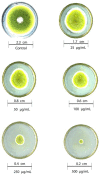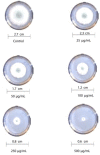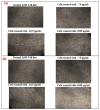The Cytotoxic Effectiveness of Thiourea-Reduced Graphene Oxide on Human Lung Cancer Cells and Fungi
- PMID: 36616058
- PMCID: PMC9823875
- DOI: 10.3390/nano13010149
The Cytotoxic Effectiveness of Thiourea-Reduced Graphene Oxide on Human Lung Cancer Cells and Fungi
Abstract
This study demonstrated the effective reduction of graphene oxide (GO) by employing thiourea as a reducing and stabilizing agent. Two fungi (Aspergillus flavus and Aspergillus fumigatus) were used for anti-fungal assay. Cell viability, cell cycle analysis, DNA fragmentation, and cell morphology were assessed to determine the toxicity of thiourea-reduced graphene oxide (T-rGO) on human lung cancer cells. The results revealed that GO and T-rGO were hazardous to cells in a dose-dependent trend. The viability of both A. fumigatus and A. flavus was affected by GO and T-rGO. The reactive oxygen species produced by T-rGO caused the death of A. flavus and A. fumigatus cells. This study highlighted the effectiveness of T-rGO as an antifungal agent. In addition, T-rGO was found to be more harmful to cancer cells than GO. Thus, T-rGO manifested great potential in biological and biomedical applications.
Keywords: Aspergillus flavus; DNA fragmentation; antifungal activity; cell viability; lung cancer cells; reduced graphene oxide.
Conflict of interest statement
The authors declare no conflict of interest.
Figures












References
-
- Katsnelson M.I. Graphene: Carbon in two dimensions. Mater. Today. 2007;10:20–27. doi: 10.1016/S1369-7021(06)71788-6. - DOI
LinkOut - more resources
Full Text Sources

